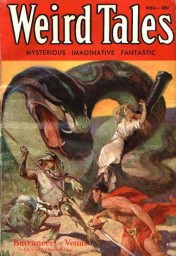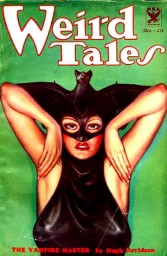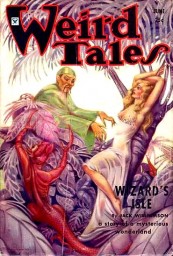 The blue versus pink science fiction and fantasy divide has been a big topic for 2015. It has the appearance of a rift of the making for the past 15 years. Actually, you can find origins for it in the 1930s.
The blue versus pink science fiction and fantasy divide has been a big topic for 2015. It has the appearance of a rift of the making for the past 15 years. Actually, you can find origins for it in the 1930s.
The big factional dispute was between the weird and science fiction fans. Robert E. Howard, H. P. Lovecraft, and Clark Ashton Smith all took a dim view of science fiction fans, some of who were very obnoxious. The science fiction fans were those generally on the offensive to patrol the science fiction magazines of any taint of the weird.
Another less known conflict happened in the pages of Weird Tales. Robert E. Howard’s character Conan the Cimmerian debuted in the December 1932 issue of Weird Tales. “The Phoenix on the Sword” tied for second place in popularity with Seabury Quinn’s “The Door to Yesterday.” Donald Wandrei’s excellent “The Lives of Alfred Kramer” took first place.
Comments were favorable in following issues in “The Eyrie.” John H. Bate of Philadelphia was on to something with: “Welcome to Conan the Reaver, Mr. Howard’s picturesque fighting man.”
The May 1933 issue featured a lone comment about Conan by Walter W. Miller:
“And also the Conan stories by Howard—I sure get a kick out of that swashbuckling soldier of fortune. The fearless way he does things grips one right up to the end of the story.”
A backlash against Conan began in the October 1933 issue. Sylvia Bennett of Detroit  wrote in to say,
wrote in to say,
“Will Robert E. Howard ever cease writing his infernal stories of ‘red battles’ and ‘fierce warfare’? I am becoming weary of his continuous butchery and slaughter. After I finish reading one of his gory stories I feel as if I am soaked with blood.”
Weird Tales contributor Jack Williamson, who would survive as one of the most long-lived writers from the pulp era, wrote to “The Eyrie” for the December 1933 issue defending “Black Colossus”:
“I was rather surprised at the brickbat aimed by Miss Sylvia Bennett at Howard’s Black Colossus, which struck me as a splendid thing, darkly vivid, with a living primitive power.”
Sylvia Bennett would return to “The Eyrie” in the June 1934 issue:
“Northwest Smith has become my idol in WEIRD TALES. Believe it or not, I’ve fallen passionately in love with him. There is a character for you! Warm, human, lovable and incredibly realistic. No barbarian baboon hot-head, this one, who slices off human and unhuman heads on the slightest pretext; nor snarls and growls at his girl-friends; nor socks his dames with such manly toughness as would make Clark Gable and Jimmy Cagney look like sissies in comparison. It is certain C. L. Moore is destined to become a popular Weird Tales author. Although Black Thirst did not reach the high standard of Shambleau, still it was an excellent job, weirdly and thrillingly beautiful.”
For those who don’t know, Northwest Smith was a series character by C. L. Moore. The stories are set in the future on planets in our solar system. Smith runs up against weird, supernatural entities. At this time, only two Northwest Smith stories had appeared.
Smith is a rather passive hero. In “Shambleau,” he rescues a strange girl from a mob on Mars. This girl seduces him but turns out to be the basis for the gorgon legend. His side-kick Yarol the Venusian saves a mucus covered Northwest Smith in the nick of time with his ray gun.
C. L. Moore’s writing style is akin to A. Merritt. It is slow moving and atmospheric. Moore became something of a one trick pony writer for Weird Tales, using variations of the same plot over and over. She broke free in the 1940s with her marriage to Henry Kuttner as a top-notch writer alone and with her husband. Her later stories (“Paradise Street,” “Heir Apparent”) took on a rather hard-boiled tone.
This is a good example of the differences of what male and female readers want. This is not something new.
What was the percentage of female readers of Weird Tales in the 1930s? My guess is around 20% at most. Farnsworth Wright, editor of Weird Tales, seemed over concerned about alienating readers, which led him to reject all too many stories by H. P. Lovecraft. Were these readers he was worried about a small but vocal female contingent?
Find yourself a copy of good old Jack Williamson’s Golden Blood, which ran in Weird Tales or the Haffner Press Collected Stories of Jack Williamson (Wizard’s Isle and Spider Island). Also, find a copy of the Ace paperback Northwest Smith by C. L. Moore.
Robert E. Howard had his female fans as well. In the January 1933 issue of Strange Tales, for example, Martha Rose wrote:
“I am writing you because I feel that I should express my appreciation for the treat you have given me with the June issue of STRANGE TALES, and also to be ungrateful enough to remind you that two months is too long to wait between issues for your thrilling stories. Can’t the publishers see fit to give us STRANGE TALES each thirty days? I am sure that they realize by this time, that their new venture is going to be a gorgeous success; at any rate, it will be if you continue to publish stories like those written by Robert E. Howard. He is, to my mind, the most delightful of your writers, and I consider his People of the Dark to be the best story you have printed to date. I hope that even Mr. Howard will eclipse himself in the future, though how anyone could ever write a more exciting story than his tale of reincarnation, I do not know.”
(Robert E. Howard World’s Greatest Pulpster 44)
Due to a typo in Pulpster, the commenter’s name should be Martha Rose Sims.
Wasn’t Henry Kuttner the guy who they said was, ‘kill a monster grab a tit, kill a monster grab a tit’?
The story of “Weird Tales” is a sad one. From the look of things it was basically killed by SJW’s.
